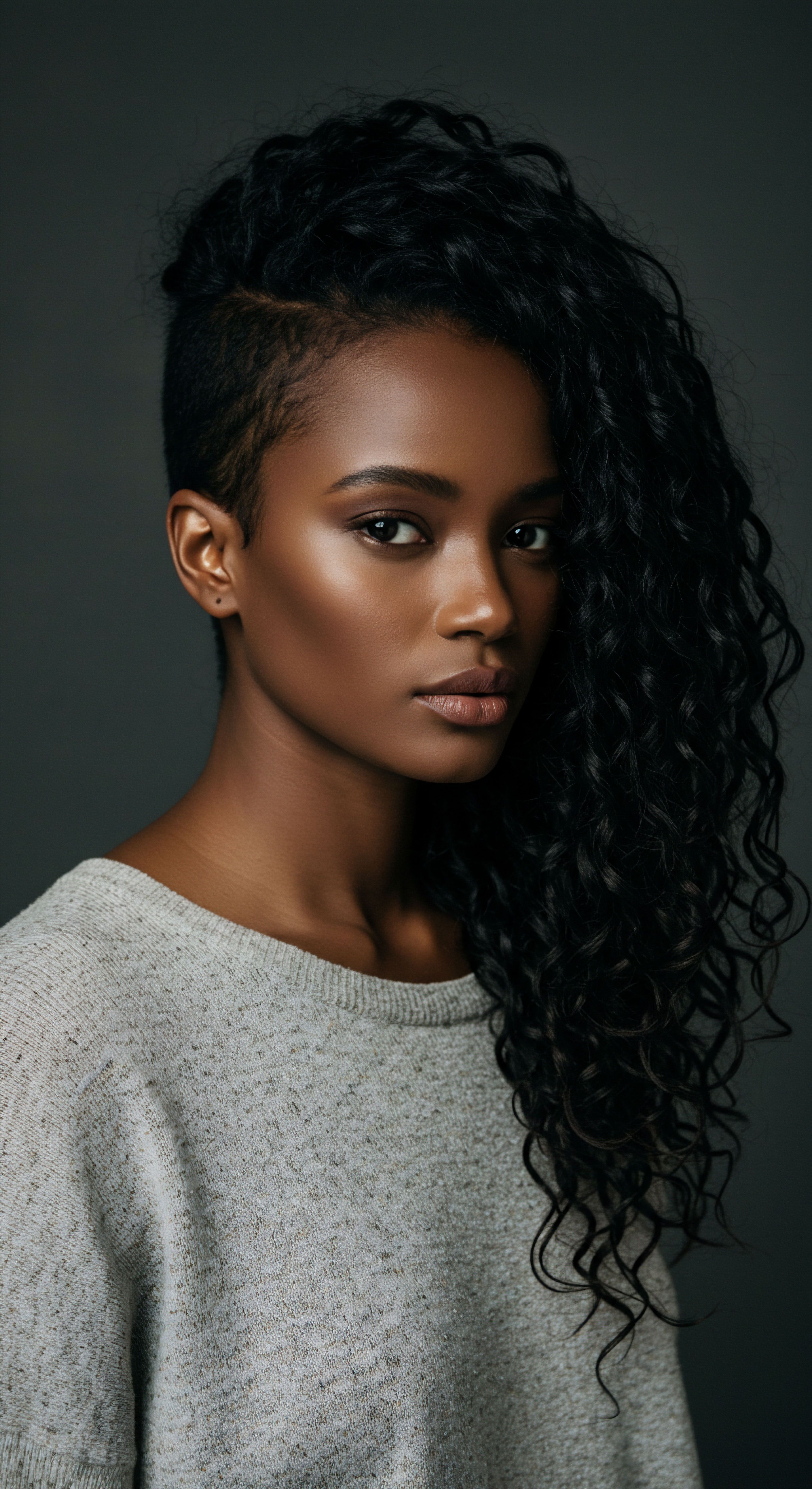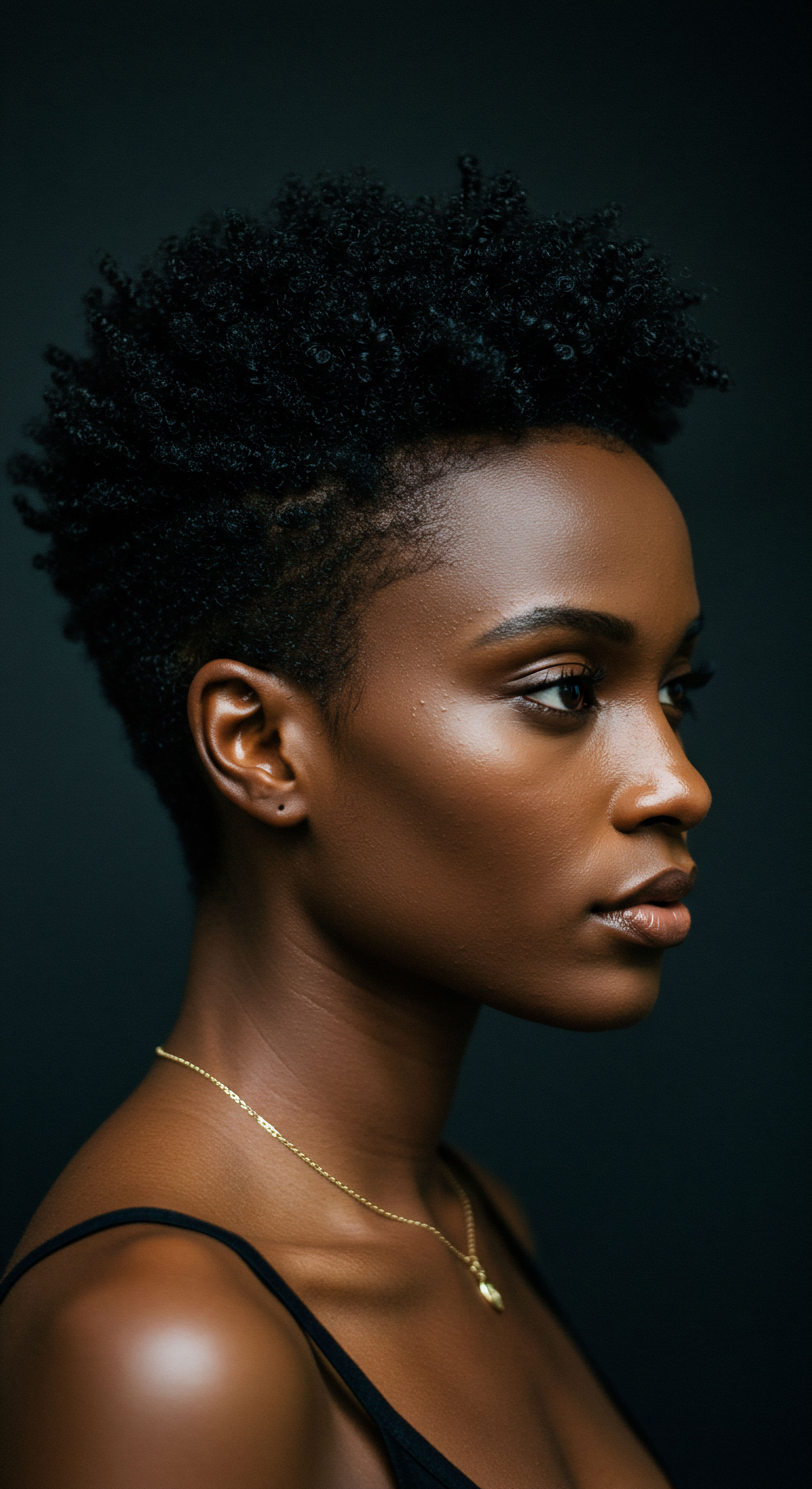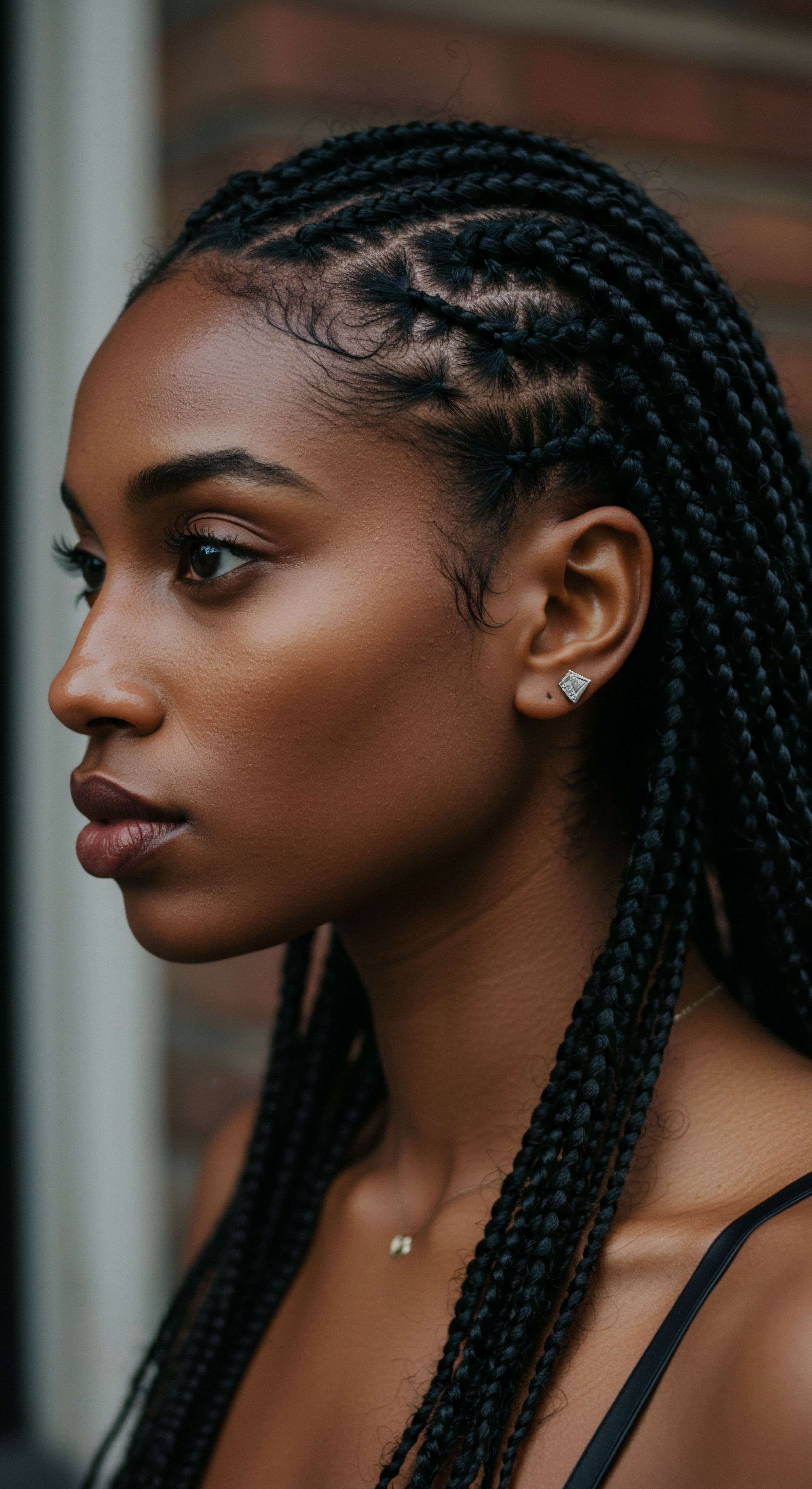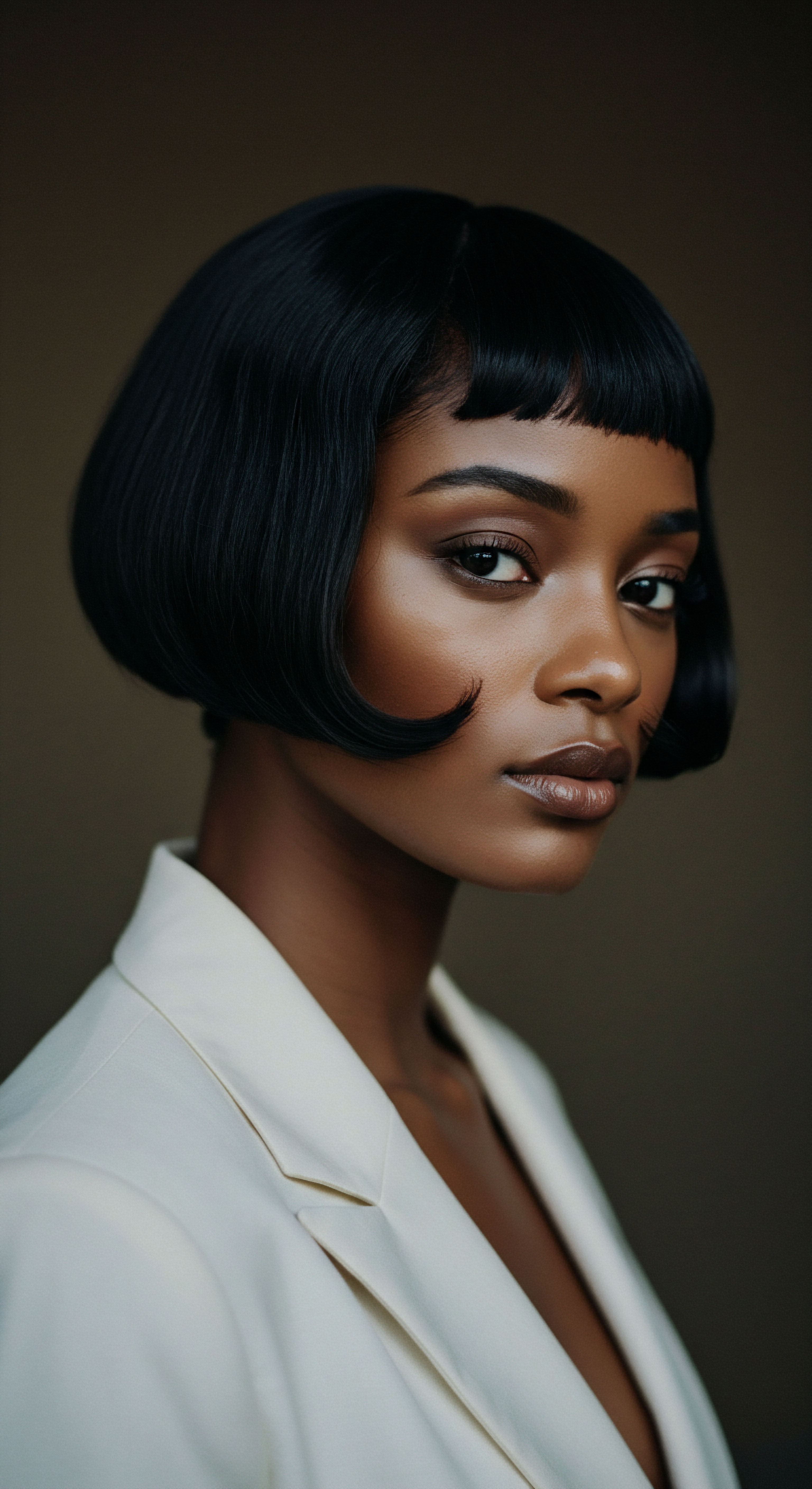
Roots
Consider the quiet wisdom held within the earth, the way ancient trees sink their foundations deep, drawing sustenance from hidden reservoirs. Our hair, too, holds a similar story, a living testament to heritage and the enduring power of connection to natural rhythms. For centuries, across continents and through generations, communities understood hair not merely as an adornment but as a vital part of identity, a conduit for self-expression, and a reflection of well-being.
This understanding, passed down through oral tradition and practiced daily, often mirrors the scientific principles we now painstakingly uncover in laboratories. The alignment is not coincidental; it speaks to an inherent knowledge of what truly nourishes and protects, a knowledge rooted in observation and respect for the natural world.

The Hair’s Foundational Structure
At its core, hair is a protein filament, primarily composed of Keratin. This protein forms a complex structure, with the outer layer, the cuticle, acting as a protective shield. Beneath the cuticle lies the cortex, which holds the hair’s pigment and strength, and for some hair types, a central medulla. The health and integrity of these layers dictate how hair responds to its environment and to care practices.
Ancient civilizations, without the benefit of electron microscopes, instinctively understood the need to preserve this delicate architecture. Their methods often focused on gentle cleansing, lubrication, and physical protection, practices that modern science confirms are crucial for maintaining the cuticle’s smooth alignment and the cortex’s strength.
Hair, a living archive of identity and culture, reflects an inherent knowledge of natural nourishment and protection.
For instance, the application of various plant-derived oils, a practice widespread in antiquity, directly addresses the need for external lipid replenishment. The hair shaft possesses a natural lipid barrier, the hydrolipidic film, which helps to seal in moisture and shield against environmental aggressors. When this film is compromised, hair becomes vulnerable to dryness and breakage.
Ancient Egyptians, for example, regularly used oils like castor, almond, and olive to condition their hair, protecting it from the harsh desert climate. Modern science affirms that oils, rich in fatty acids and ceramides, support the skin’s lipid barrier function and prevent transepidermal water loss, effectively mimicking and supplementing the hair’s natural protective layer.

Melanin and Environmental Resilience
Beyond its structural proteins, hair contains Melanin, the pigment responsible for its color. Melanin exists in two primary forms ❉ eumelanin, which gives rise to darker shades, and pheomelanin, which contributes to lighter, reddish tones. This pigment, especially eumelanin, plays a vital role in protecting hair from ultraviolet (UV) radiation.
Darker hair, with higher concentrations of eumelanin, exhibits greater resistance to UV rays and environmental degradation compared to lighter hair. This scientific understanding provides a compelling backdrop to traditional practices in sun-drenched regions, where protective styling and oiling would have offered additional layers of defense against the elements.
- Keratin ❉ The primary protein making up hair, providing its structural framework.
- Cuticle ❉ The outermost protective layer of the hair shaft.
- Cortex ❉ The inner layer of hair, containing pigment and contributing to strength.
- Hydrolipidic Film ❉ A natural lipid barrier on the hair and scalp that retains moisture.
- Melanin ❉ The pigment that determines hair color and offers UV protection.
The interplay between hair’s biological makeup and its environment shaped ancient care practices. Cultures adapted to their specific climates, selecting local botanicals that offered specific benefits. This localized wisdom, accumulated over generations, often aligned with the hair’s intrinsic needs for moisture, strength, and protection.

Ritual
Stepping from the foundational elements of hair into the realm of daily practice, we recognize how ancient care was never a mere chore but often a deliberate ritual, imbued with intention and connection. Consider the mindful gestures of applying oils, the patient unbraiding of strands, or the rhythmic combing of hair. These acts, repeated over time, speak to a deep respect for the body and its natural processes. Modern hair care, in its hurried efficiency, sometimes loses sight of this deliberate pace, yet the underlying principles of ancient rituals offer powerful lessons for maintaining hair integrity today.

What Ancient Cleansing Methods Align with Modern Hair Science?
Before the advent of synthetic shampoos, ancient civilizations relied on natural ingredients for cleansing. Clay, plant extracts, herbs, and even fermented liquids were used to purify the scalp and strands. In India, Ayurvedic texts dating back thousands of years describe the use of ingredients like Amla, Shikakai, and Neem for hair cleansing and scalp nourishment. Similarly, Native American tribes utilized yucca root, crushed and mixed with water to form a soapy lather.
Modern science validates the efficacy of many of these traditional cleansing agents. Many plants contain natural Saponins, compounds that create a mild lather and possess cleansing properties without stripping the hair’s natural oils as harshly as some modern sulfates. The practice of “oil cleansing,” for instance, used by ancient Egyptians with castor and olive oils, leverages the chemical principle that “like dissolves like.” Oils effectively dissolve excess sebum, environmental pollutants, and product buildup while preserving the scalp’s crucial moisture barrier. This approach contrasts sharply with the often harsh, stripping action of some conventional shampoos, which can disrupt the scalp’s delicate microbiome and lead to dryness.
Ancient cleansing, with its gentle, natural agents, often honored the hair’s innate balance, a lesson for contemporary routines.
The Red Yao women of China provide a compelling contemporary example of ancient wisdom in action. Their centuries-old hair care ritual involves fermented rice water, which they use for cleansing and strengthening. This traditional method, involving a 7-10 day fermentation process, boosts nutrient levels in the water. Scientific analysis reveals that fermented rice water is rich in Inositol, which repairs damaged hair at a molecular level, Panthenol, which forms a protective barrier, and Amino Acids that strengthen the hair shaft.
Users of this method have reported a 62% reduction in breakage after just eight weeks, alongside noticeable improvements in shine and texture. This case study highlights how traditional fermentation methods enhance the bioavailability and potency of natural ingredients, offering tangible benefits that align with modern understanding of hair repair and fortification.
| Ancient Ingredient Amla, Shikakai, Neem |
| Traditional Use Cleansing, scalp nourishment (Ayurveda) |
| Modern Scientific Alignment Contain saponins, antioxidants; support scalp health. |
| Ancient Ingredient Yucca Root |
| Traditional Use Natural shampoo (Native American) |
| Modern Scientific Alignment Contains saponins for gentle lather and cleansing. |
| Ancient Ingredient Castor Oil, Olive Oil |
| Traditional Use Oil cleansing (Ancient Egypt) |
| Modern Scientific Alignment Dissolve sebum, maintain moisture barrier, rich in fatty acids. |
| Ancient Ingredient Fermented Rice Water |
| Traditional Use Cleansing, strengthening (Red Yao Women) |
| Modern Scientific Alignment High in inositol, panthenol, amino acids for repair and protection. |

Moisture Retention and Protective Styling
Maintaining moisture is a universal challenge for hair, particularly for textured hair types which are often prone to dryness due to their structural characteristics. Ancient practices frequently centered on moisture retention. Oils were not only for cleansing but also for conditioning and sealing hydration.
Coconut oil, deeply rooted in ancient Ayurvedic practices, has been scientifically proven to penetrate the hair shaft, preventing protein loss and reducing hair damage. Olive oil, another staple, improves hair elasticity and reduces breakage.
Protective styling, such as braiding and twisting, has a long lineage across various cultures, especially within African and African-descendant communities. These styles served not only aesthetic and cultural purposes but also shielded hair from environmental damage and reduced manipulation, thereby minimizing breakage. Modern trichology supports this, recognizing that protective styles help retain length by limiting exposure to external stressors and reducing daily styling friction.
The emphasis on gentle manipulation, minimal heat, and the regular application of nourishing oils and butters in ancient practices finds a direct parallel in contemporary recommendations for maintaining the integrity of textured hair. The layering technique, often referred to as the LOC (Liquid, Oil, Cream) or LCO (Liquid, Cream, Oil) method, is a modern approach to moisture retention widely used for textured hair. This method, where liquid hydrates, oil seals, and cream moisturizes, effectively replicates the principles of layering emollients observed in ancient traditions.

Relay
As we move beyond the direct echoes of ancient practices in modern hair care, a deeper current reveals itself ❉ the profound interplay between cultural identity, societal pressures, and the very health of our hair. The journey of hair care, from antiquity to the present, is not a simple linear progression of scientific discovery, but a complex dialogue between inherited wisdom, aesthetic aspirations, and the lived experiences of individuals. Understanding this layered conversation allows us to appreciate how seemingly disparate historical practices and contemporary scientific findings actually speak to common truths about hair integrity and human well-being.

How Do Societal Pressures Impact Hair Health and Care Practices?
For many communities, particularly those of African descent, hair holds immense cultural meaning and value, with traditions stretching back to pre-slavery days. However, this deep connection has often been challenged by Eurocentric beauty standards that have historically marginalized natural textured hair. This societal pressure has led to the widespread adoption of chemical straightening methods, such as relaxers, which contain strong alkalis that break down bonds within the hair, weakening the strand. While offering a desired aesthetic, these chemical treatments can cause significant damage, leading to dryness, breakage, and scalp issues.
A striking data point highlights this complex dynamic ❉ a study by researchers at The Ohio State University Wexner Medical Center found that 95% of primary care doctors had conversations about exercise with their African American female patients, yet more than three-quarters had never discussed how hair care might affect physical activity. This disconnect points to a broader issue ❉ the unspoken societal pressures that lead individuals to prioritize hair appearance over physical health. For many Black women, the time and financial investment in maintaining certain hairstyles can be a barrier to regular exercise, as sweat and moisture necessitate re-styling.
This illustrates how cultural practices, while deeply meaningful, can sometimes, when influenced by external beauty standards, create unintended health disparities. The solution, as researchers suggest, lies in increased education about diverse hair care practices and culturally sensitive counseling from healthcare providers.
The alignment of hair care practices with scientific understanding extends beyond ingredients to the profound influence of culture and identity.

Beyond the Surface ❉ The Microscopic Story of Hair Integrity
Modern scientific tools allow us to peer into the microscopic world of hair, revealing the intricate details of its integrity. Techniques like scanning electron microscopy and vibrational spectroscopy can illustrate structural changes, including the breakdown of disulfide bonds and amide groups, which are vital for hair strength. Research comparing ancient hair samples from mummified remains with modern hair has shown that while some degradation occurs over millennia, the overall amino acid profiles remain remarkably similar to modern hair. This suggests a fundamental resilience in hair’s protein structure, capable of withstanding considerable time and environmental exposure, a testament to its inherent design.
Consider the role of Lipids, not just as external coatings but as integral components within the hair fiber itself. Lipids constitute 2-6% of the hair’s overall weight and are critical for maintaining the hair’s structure and preventing moisture loss. They act as a cement between cuticle layers, lubricating them and preventing splitting and breakage. When these internal lipids are depleted, hair exhibits signs of damage such as split ends, loss of shine, and reduced elasticity.
Ancient practices, with their consistent use of natural oils like coconut and olive, were unknowingly providing these essential lipids, supporting both the external protective barrier and the internal structural integrity of the hair. Coconut oil, for example, is particularly effective due to its ability to penetrate the hair shaft, reducing protein loss and supporting moisture retention.
- Protein Loss ❉ The degradation of keratin, which weakens the hair shaft.
- Disulfide Bonds ❉ Chemical bonds within keratin that provide hair strength and shape.
- Lipid Depletion ❉ Reduction of natural fats within and on the hair, leading to dryness and damage.
- Traction Alopecia ❉ Hair loss caused by prolonged tension on hair follicles from tight styles.
The wisdom of traditional methods, often dismissed as anecdotal, finds powerful validation in contemporary scientific analysis. For instance, the use of various African plants for hair treatment, targeting issues like alopecia and dandruff, is now being studied for its scientific basis. While more research is needed, traditional knowledge has led to the identification of plants with potential medicinal properties that align with modern dermatological goals.
| Ancient Practice/Observation Using oils for conditioning and protection. |
| Modern Scientific Explanation Oils provide lipids, strengthening the hydrolipidic film and penetrating the hair shaft to reduce protein loss. |
| Impact on Hair Integrity Reduces dryness, breakage, and improves elasticity. |
| Ancient Practice/Observation Protective styling (braids, twists). |
| Modern Scientific Explanation Minimizes manipulation, reduces exposure to environmental stressors. |
| Impact on Hair Integrity Preserves length, prevents mechanical damage. |
| Ancient Practice/Observation Reliance on natural cleansing agents. |
| Modern Scientific Explanation Saponins in plants offer gentle cleansing without harsh stripping. |
| Impact on Hair Integrity Maintains scalp microbiome balance, reduces dryness. |
| Ancient Practice/Observation Challenges of chemical straightening. |
| Modern Scientific Explanation Alkaline chemicals break disulfide bonds, weakening hair structure. |
| Impact on Hair Integrity Increased fragility, dryness, and potential for breakage and scalp burns. |
| Ancient Practice/Observation Ancient practices often align with modern scientific understanding by prioritizing protection, gentle care, and natural ingredients. |
The dialogue between ancient practices and modern science reveals a shared pursuit ❉ the preservation of hair integrity. While our tools and vocabulary have evolved, the underlying principles of nourishment, protection, and respectful handling remain constant. The contemporary challenge lies in discerning which elements of historical wisdom offer true benefits, supported by rigorous investigation, and how to integrate them thoughtfully into a hair care landscape often dominated by synthetic solutions and fleeting trends.

Reflection
The journey through ancient hair care practices and their alignment with modern scientific understanding reveals a profound and continuous human quest for well-being. It is a story not of simple evolution, but of enduring principles rediscovered, of a gentle wisdom that echoes across time. Our hair, a testament to personal and collective histories, thrives when treated with respect for its natural architecture and its intrinsic needs.
The whispers of old traditions, the meticulous observations of ancestors, now find their voice in the language of molecules and cellular processes. This ongoing conversation between past and present reminds us that the deepest secrets to vibrant hair may not always lie in the newest innovation, but often in the patient, observant care that has sustained generations.

References
- McCreesh, N. C. Gize, A. P. & David, A. R. (2011). Ancient Egyptian Hair Gel ❉ New Insight into Ancient Egyptian Mummification Procedures through Chemical Analysis. Journal of Archaeological Science, 38(12), 3432–3434.
- Bonnichsen, R. Johnson, D. L. Stafford, T. W. & Morlan, R. E. (2001). Methods for the Study of Ancient Hair ❉ Radiocarbon Dates and Gene Sequences from Individual Hairs. Journal of Archaeological Science, 28(7), 779-787.
- Goddard, N. (2020). Melanin for Hair ❉ What Role It Plays & How to Increase Production. Healthline.
- Tolliver, S. (2019). Doctors don’t realize societal hair care pressures prevent many African American women from working out. Ohio State Medical Center.
- Maharaj, C. (2025). Beyond the roots ❉ exploring the link between black hair and mental health. TRIYBE Research.
- Rele, J. S. & Mohile, R. B. (2003). Effect of mineral oil, sunflower oil, and coconut oil on prevention of hair damage. Journal of Cosmetic Science, 54(2), 175-192.
- Messara, L. (2023). The Legacy of Lathers ❉ Tracing the Historical Use of Natural Ingredients in Hair Cleansing. Vertex AI Search.
- Clinical, L. (2025). Modern Beauty from the Ancient Egyptian Empire. Lira Clinical.
- Safic-Alcan. (2024). Hair Care through the ages ❉ Inspired by the past, Designed for the future. Safic-Alcan.
- Quora. (2019). How did people wash their hair in the past? Was there any form of shampoo? Quora.
- Clinikally. (2024). Demystifying Natural Hair Shrinkage ❉ Strategies for Length Retention and Care. Clinikally.
- Egyptra. (2025). From Ancient Egypt to Modern Beauty ❉ Timeless Cosmetic Secrets. Egyptra.
- African Hair Summit Festival. (2024). Why Embrace Your Natural Hair? Benefits Beyond Beauty. African Hair Summit Festival.
- NYSCC. (2020). An Overview on Hair Porosity. NYSCC.
- Rolling Out. (2025). The ancient haircare secret that’s backed by modern science. Rolling Out.